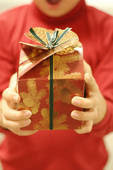
Warm wishes
The winter images shown here have been discontinued but the basic card design is a fun one that shows a great way to use the mini clothespins. Stamp the solid bar with chocolate brown ink and then attach the clothespins with crafter's pick. It's our favorite glue for a project like this, the paper will tear before the clothespin will fall off.
Items used:
Crafter's Pick
4813E - thick stripe
Clothes Pins - natural
Encore ink - honeydew

Three Presents
We love to use the blocks in creative ways. Here three different sized blocks were stamped with gold and merlot inks. After masking each block, word stamps were stamped over them. Notice how the words are offset so they appear to wrap around the box. Slits were made for the ribbon and each box was then wrapped with different but coordinating ribbons.
Items used:
4546A - small rectangular block
4545C - rectangular block
4547B - block
4835B - holiday cheer
4831B - merry christmas

Happy Holiday tag
These tag cards are quick and simple to make. Stamp the snowflakes and blocks with a gold pad. Then go back and stamp the fun winter images over the blocks of gold. Finish off the card with a bit of ribbon to add a festive touch. These tags fit in Memory Box slim envelopes.
Items used:
4547B - block
4821D - happy holidays
4723B - snowflake
Encore - gold
Colorbox ink - merlot, alpine

Swirl Star Tree Card
Don't forget to use the idea of attaching a tag to a card for an embellishment. We love to use our favorite silver metallic cording to further enhance the project.
Items used:
Impress Ink - olive green
Metallic Cord

Sticky Stuff
Create holiday magic using a fun product called Sticky Stuff. It's a powder that when heated, becomes sticky. To make this card, first stamp an image and color it in. Then take a block stamp and stamp it over the image using Versamark ink. Apply the embossing powder as usual. Heat it until it gets shiny and then sprinkle on the prisma glitter for a perfectly shaped oval that sparkles!
Items used:
Sticky Stuff
Prisma Glitter
4838E - Oval Stamp

Heavenly Joy
To make a card like this, use canvas white PolyShrink. First lightly sand the Polyshrink. Then stamp your image onto it using black Brilliance ink. Color the image with prismacolor pencils and cut it out. Use a heat gun to shrink the plastic. A stencil was cut out of paper and blue ink was applied to the edges to create the clouds.
Items used:
PolyShrink - Canvas white and Sanding blocks
Silver paper
Prismacolor pencils
(Source: impressrubberstamps.com)







